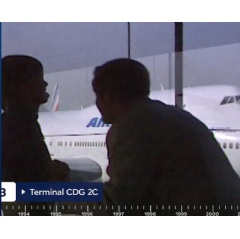Air France, a main operator at Paris-Charles de Gaulle airport for the past 50 years
50 years of Paris CDG Airport with Air France
Charles de Gaulle airport was inaugurated just 50 years ago, on 13 March 1974. A futuristic project and icon of brutalist architecture, this monumental infrastructure would over the years become the European Union’s leading gateway. In 1996, Air France set up its global hub in this veritable city, where travellers from across the globe cross paths every day. Today, the airline accounts for more than half the airport’s traffic, connecting Paris to over 200 destinations in almost 100 countries worldwide.
Let’s take a look back at 50 years of Air France operations at Paris-Charles de Gaulle, the beating heart of a global network.
As early as the 1950s, the need for a third Parisian airport became apparent as traffic grew at the capital’s historic airports, Paris-Le Bourget and Paris-Orly.
Terminal 1 of the new Paris-Charles de Gaulle airport was inaugurated on March 8, 1974 by French Prime Minister Pierre Messmer, after eight years of construction.
Designed by the young architect Paul Andreu, this first terminal featured an innovative design: a central circular building linked to seven satellites. Designed to facilitate the distribution of passenger flows, this singular structure earned the terminal its nickname, which is still used today, the Camembert.
The first Air France flight from Paris-Charles de Gaulle took off on April 30, 1974. The Caravelle F-BHRA, the first aircraft of its type delivered to Air France, took off for Belgrade and Sofia, with a crew led by flight captain Henri Cibert.
The company’s flights were gradually migrated to Paris-Charles de Gaulle, initially serving domestic (Bordeaux, Nice, Toulouse) and European destinations (London, Geneva, Frankfurt, Turin and Lisbon).
The bulk of its activity was relocated in November 1974, with two-thirds of the national carrier’s flights and part of its maintenance operations transferred to Paris-Charles de Gaulle. The airport then known as Paris-Roissy Charles de Gaulle became Air France’s main hub.
Two years later, in 1976, the Concorde joined the Air France fleet and flew at supersonic speed to Dakar, Rio de Janeiro, Caracas, Washington, Dallas and New York JFK. Paris was now 3.5 hours from New York, and customers travelling on board the Concorde benefitted from a dedicated airport experience and lounge.
Buoyed by growing traffic, Paris-Charles de Gaulle underwent several transformations and expanded. Air France relocated several times to offer its customers dedicated, ever more comfortable infrastructures, adapted to the company’s growth.
From 1982 onwards, the opening of terminal 2 at Paris-Charles de Gaulle enabled Air France to expand its network, particularly in Europe. Thanks to its brand-new fleet of medium-haul aircraft (Boeing 737, then Airbus A320), the company multiplied its routes and offered an increasingly dense network. By 1988, Air France was serving the highest number of destinations in Europe.
In 1996, the year terminal 2E was opened, Air France embarked on a major restructuring. The airline reorganized its operations to turn Paris-Charles de Gaulle into a hub for connecting flights: 7 coordinated connecting banks were organized throughout the day, connecting short- and medium-haul flights with long-haul flights. Flight operations were better distributed, connections quicker and easier, and Paris-Charles de Gaulle became a real global hub. This major project enabled the airline to operate up to 60 flights an hour, and to welcome an increasing number of passengers.
In 2000, Paris-Charles de Gaulle added a fourth runway, a first in Europe.
Terminal 2E also underwent several phases of growth, with the opening of Hall L in 2007, followed a few years later by Hall M. These successive extensions enabled the terminal to increase its capacity by 20 million passengers a year. To facilitate connections, Air France’s partner airlines, notably Skyteam alliance members, were based in the terminals operated by Air France.
Connectivity is one of the main assets of Paris-Charles de Gaulle, the only Paris airport directly linked to the RER B and equipped with a TGV station. This rail connection enables Air France to develop its intermodal offer with the SNCF, and to give customers the possibility of combining rail and air travel via a single ticket.
50 years after its inauguration, Paris-Charles de Gaulle now boasts 9 terminals. France’s largest airport and Europe’s second largest, it is the European Union’s main gateway.
As the airport’s main operator, with 50% of traffic, Air France operates 650 departing and arriving flights a day, and offers 25,000 connecting opportunities per week in less than 2 hours. 100,000 Air France customers are welcomed every day, some of whom visit the company’s 6 lounges (Business and Flying Blue Elite lounges in terminals 2F, 2G, 2E Hall K, L and M, La Première lounge in terminal 2E).
The lounge in terminal 2F is the latest space to be inaugurated by Air France and welcomes the company’s business and Flying Blue Elite Plus customers over two levels. Through the curved window offering a “runway view”, designed by architect Sanjit Manku and designer Patrick Jouin, customers can admire the 240 or so aircraft sporting the colors of the French airline, as they prepare to jet off to 200 destinations worldwide.
( Press Release Image: https://photos.webwire.com/prmedia/7/319299/319299-1.jpg )
WebWireID319299
This news content was configured by WebWire editorial staff. Linking is permitted.
News Release Distribution and Press Release Distribution Services Provided by WebWire.

